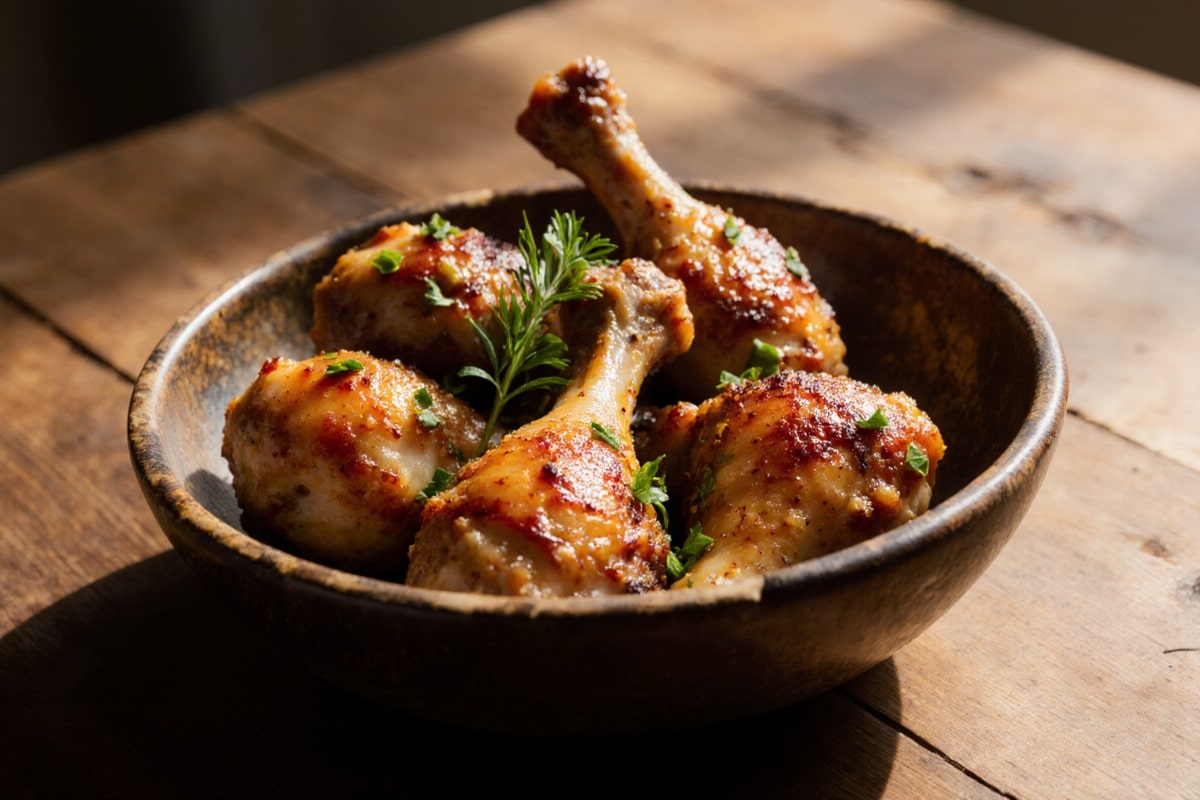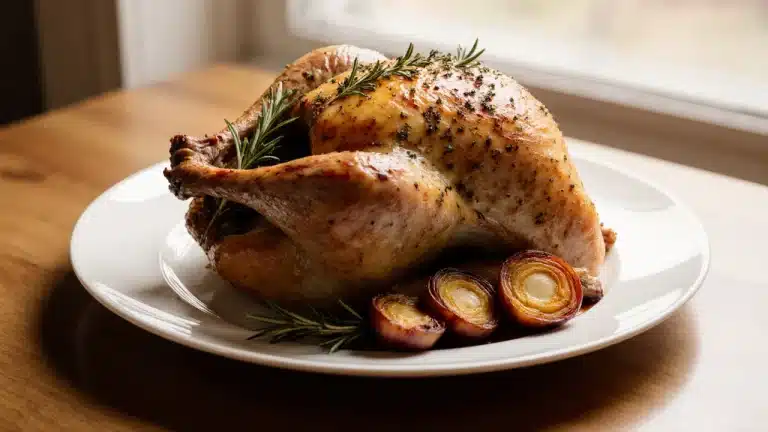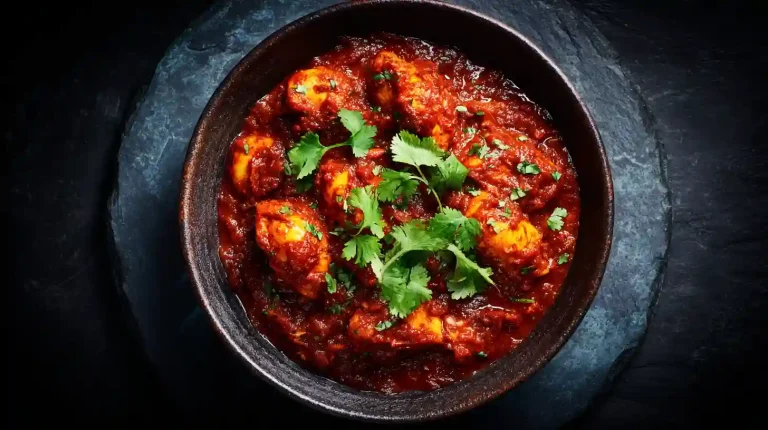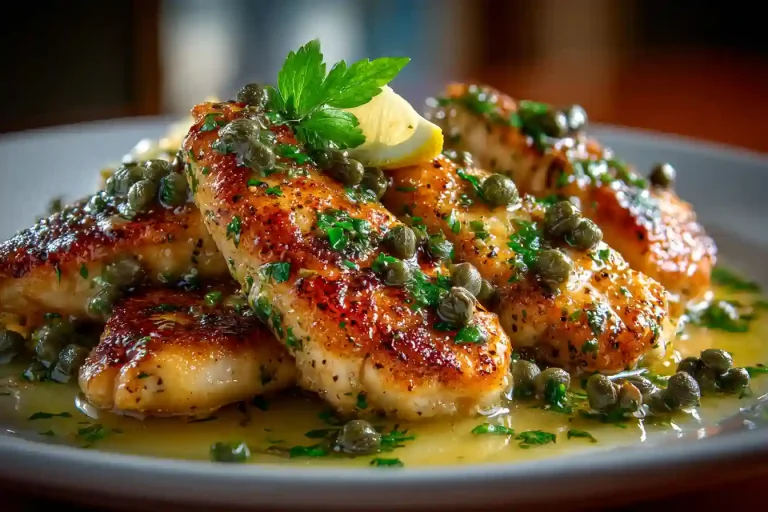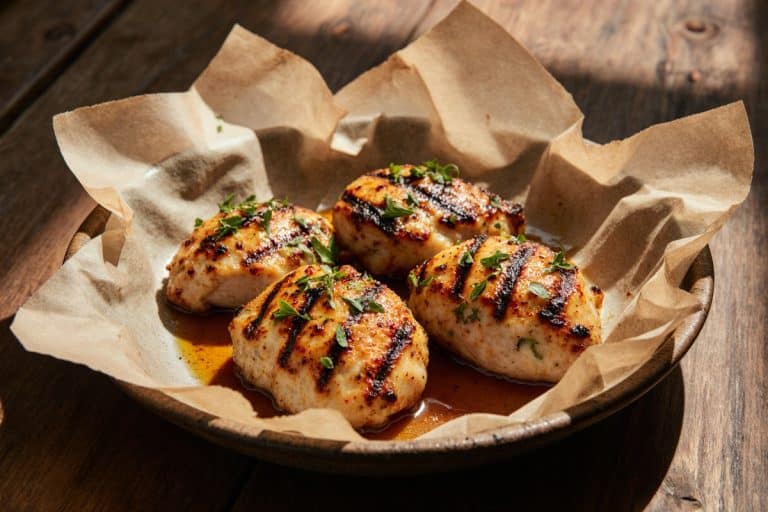Gordon Ramsay Chicken Drumsticks Recipe
Gordon Ramsay chicken drumsticks are my secret weapon for quick, flavorful meals. I used to think chicken was just chicken — until I discovered how to elevate it with Ramsay’s techniques. Imagine sinking your teeth into crispy, perfectly seasoned skin while the juicy meat pulls away from the bone. It’s a game changer! With just a handful of ingredients and a few clever tricks, you too can nail this recipe without turning your kitchen into a war zone. Trust me, no more undercooked, soggy messes on your plate! You’ll save time, boost your confidence, and serve a dish that makes dinner feel like a gourmet experience every time.

Ingredients, tools and prepping for gordon ramsay chicken drumsticks
Exact ingredients and quantities for an 8-drumstick batch
This shopping list covers 8 bone-in chicken drumsticks (about 1.0–1.2 kg total). You’ll need: 8 drumsticks (about 120–150 g each), 2 tbsp (30 ml) olive oil, 1½ tsp fine sea salt (9 g), 1 tsp black pepper (2 g), 1 tsp smoked paprika (2 g), 1 tsp garlic powder (3 g), and 1 tbsp (15 g) brown sugar if you want a sticky finish. For a simple marinade, swap the olive oil for 60 ml plain yogurt and add 1 tbsp lemon juice (15 ml) and 1 tsp ground cumin (2 g).
Tools: kitchen thermometer (probe), oven or grill, rimmed baking tray, wire rack, tongs, mixing bowl, and a fish slice or spatula.
Tip: use a probe thermometer to confirm an internal temp of 74°C / 165°F — eyeballing is where dinners fail. Quantities are scaled for 8 pieces; scale everything up or down evenly.
Kitchen tools and setup — what makes crisp skin possible
Crisp skin comes from dry surface, direct heat and good air flow. Use a rimmed tray with a wire rack so hot air circulates underneath; if you don’t have a rack, rotate the drumsticks halfway through cooking. Preheat the oven (or air fryer/grill) so the drumsticks go into hot equipment — that jump-starts the Maillard reaction.
Stick a probe thermometer into the thickest part of a drumstick without touching the bone for live readings. For stovetop work, a heavy skillet (cast iron preferred) holds heat better and gives a cleaner sear.
Tip: pat each drumstick very dry with paper towel before oiling — moisture turns to steam, and steam kills crisp. Have a tray ready for resting and cover it loosely with foil.
Butchery, trimming and safe handling before cooking
Check each drumstick for excess fat, loose skin or bone fragments; trim only what’s obviously hanging, leaving most skin intact for flavor and protection. For even cooking, pick drumsticks that are similar in size or tie oversized pieces with butcher’s twine to match.
Always wash hands and sanitize surfaces after touching raw poultry like drumsticks; don’t rinse chicken under water — you’ll just spread bacteria around the sink.
Tip: keep a dedicated board for raw poultry to avoid cross-contamination. Store raw drumsticks below 4°C (40°F) and cook within 1–2 days of purchase unless you freeze them. If frozen, thaw in the fridge overnight or use the cold-water method in sealed packaging.
Roasting in the oven for the crispiest skin
Oven temperature, timing and rack placement for perfect roast
Preheat your oven to 220°C (425°F). Arrange the drumsticks on a wire rack set over a rimmed baking tray, skin side up, leaving 2–3 cm between pieces so air can circulate. Roast for 25–30 minutes, then check with a probe thermometer — aim for a core temp of 74°C (165°F).
If you use convection, drop the temp to 200°C (400°F) and expect the shorter side of the time range. For extra crisp, turn on the grill/broiler for 2–3 minutes at the end and watch closely.
Tip: don’t crowd the tray — crowded drumsticks steam instead of roast. Rest for 5–7 minutes after cooking so juices settle back into the meat.
How to prep the skin and what fats work best
Pat the skin completely dry with paper towels. Rub each drumstick with 2–3 ml (about ¼ tsp) olive oil — enough to coat but not pool — then season.
For a crisper finish, a light dusting (1–2 tsp) of aluminium-free baking powder mixed with the dry spices helps draw moisture from the skin and speeds browning.
Butter adds flavor but will burn at high heat; mix it with oil and brush on in the last 5 minutes of roasting for a buttery glaze without scorching.
Tip: apply sticky glazes (honey, BBQ) in the final 5–10 minutes to avoid burning sugars. Keep an eye on the color during the last few minutes.
Checking doneness and food safety — exact temperatures and resting
Insert a probe thermometer into the thickest part without touching bone; the safe minimum internal temperature for poultry is 74°C (165°F). If pieces hit 74°C but there’s still visible pink near the bone, cook a little longer until the color clears — temperature is what matters.
Carryover cooking will raise the temp by about 2–3°C during a 5–10 minute rest. Rest drumsticks loosely tented with foil for 5–7 minutes; cutting right away spills juices and dries the meat.
Tip: when testing multiple pieces, check the thickest one — smaller pieces can finish earlier. Refrigerate leftovers within 2 hours and eat them within 3–4 days.
Pan-searing and finishing — a fast, flavorful stovetop method
Exact sear times, oil choices and temperature control
Heat a heavy skillet (cast iron preferred) over medium-high to high until the oil is nearly smoking (surface ~200–220°C). Add 1 tbsp (15 ml) high smoke-point oil such as grapeseed, vegetable or sunflower.
Place drumsticks skin side down and press so the skin makes full contact; sear 3–4 minutes without moving to build a deep golden crust. Turn and sear the other sides for 2–3 minutes.
Reduce heat to medium and add an oven-safe lid, or transfer to a 200°C (400°F) oven to finish cooking for another 12–18 minutes depending on size, aiming for 74°C (165°F) internal.
Tip: avoid overcrowding the pan — sear in batches if needed. Use tongs, not forks, to avoid puncturing the skin.
Finishing techniques — covered braise versus oven finish
After searing, you can finish two ways. For a braised, tender result, add 150 ml stock or wine, reduce heat to low, cover and simmer 20–25 minutes until 74°C. This softens connective tissue but will soften the skin.
For crisp skin, transfer the seared drumsticks to a preheated oven at 200°C (400°F) on a wire rack for 12–15 minutes. The oven finish keeps the seared texture while cooking through evenly.
Tip: if you made a pan sauce, reduce it while the drumsticks rest and spoon it over at service. Pick the method based on the texture you want.
Common pan mistakes and quick fixes
Burned outside with raw inside: lower the initial heat, sear in shorter bursts and finish in the oven. Soggy skin: dry thoroughly before cooking and avoid covering until almost done. Overcrowding leads to steaming — cook in batches.
Meat sticking to the pan: make sure the fat is hot before adding chicken; if it sticks, wait until the crust releases naturally before turning. Tough, dry meat: remove from heat at 74°C and rest 5–7 minutes tented with foil.
Tip: if you overcook slightly, shred the meat and use it in salads or enchiladas to rescue texture. Keep a thermometer handy — it turns guesswork into repeatable results.
Grill and air fryer — quick comparisons and exact settings
Grilling drumsticks — direct vs indirect heat, temps and timing
For charcoal or gas grill, set up two zones: direct high heat (~230–260°C / 450–500°F) and indirect medium heat (~180°C / 350°F). Sear drumsticks 2–3 minutes per side over direct heat to get char, then move to indirect heat and cook for 18–24 minutes with the lid closed, turning every 6–8 minutes.
Use a probe to confirm 74°C (165°F). If you cook only over direct heat, pick smaller drumsticks and watch closely — about 12–16 minutes total.
Tip: oil the grates or brush drumsticks lightly to prevent sticking. On a gas grill, keep a spray bottle of water handy for flare-ups from dripping fat.
Air fryer settings, spacing and timing for consistent crisp
Preheat the air fryer to 200°C (400°F). Lightly oil drumsticks and arrange in a single layer with space between pieces — don’t stack. Cook 10 minutes, flip, then cook another 6–10 minutes until the internal temp reads 74°C (165°F).
Air fryers run strong convection, so small pieces will cook fast; check earlier to avoid overcooking. For sticky glazes, brush them on in the last 3–4 minutes.
Tip: don’t overcrowd the basket — work in batches and flip or shake halfway for even browning.
Method comparison — texture, time, and best use for each cook style
Oven roasting gives consistent, even heat and is forgiving for larger batches — expect 25–35 minutes at 220°C depending on size.
Pan-searing gives quick color and flavor with less active time but usually needs an oven or braise finish. Grilling adds smoke and char but requires two-zone control. Air fryer is fastest for crispy results with minimal oil, usually 16–20 minutes total.
Pick the method by what you want: char and smoke (grill), reliable batch cooking (oven), quick weeknight crisp (air fryer), or best seared crust (skillet + oven finish).
Tip: always target 74°C (165°F) internal temp regardless of method — taste means nothing if it isn’t safe. Adjust tools and times to the drumstick size.
Flavor variations, rubs and glazes — three distinct profiles
Classic smoky BBQ rub and sticky glaze (quantities)
For 8 drumsticks: mix 2 tbsp (30 g) brown sugar, 1 tbsp smoked paprika (7 g), 1½ tsp salt (9 g), 1 tsp black pepper (2 g), 1 tsp garlic powder (3 g), ½ tsp cayenne (1 g). Rub onto oiled drumsticks and rest 30–60 minutes or overnight in the fridge.
Roast at 200°C (400°F) for 25–30 minutes, brushing with 80 ml BBQ sauce diluted with 1 tbsp water in the last 8 minutes to build a sticky gloss.
Tip: apply high-sugar sauces in the last 8–10 minutes to avoid burning. You’ll get a balanced sweet-smoky glaze with caramelized edges.
Asian-inspired spicy-sweet marinade (exact measures)
Combine 60 ml soy sauce, 2 tbsp honey (30 g), 1 tbsp rice vinegar (15 ml), 2 tsp sesame oil (8 ml), 2 cloves garlic crushed, and 1 tsp grated ginger. Marinate drumsticks for 30 minutes to 4 hours.
Roast or air-fry at 200°C (400°F) for 18–25 minutes until 74°C (165°F), brushing the marinade on in the last 6–8 minutes. For extra heat, add 1 tsp gochujang or ½ tsp chili flakes.
Tip: reserve some marinade before adding raw chicken for a finishing glaze or boil it for a minute to use as a sauce. The soy-honey balance gives sticky, savory-sweet skin.
Herb-citrus Mediterranean option and finishing
Zest and juice one lemon, mix with 3 tbsp olive oil (45 ml), 2 tbsp chopped rosemary, 2 tbsp chopped parsley, 3 cloves minced garlic, 1 tsp salt and ½ tsp black pepper. Marinate 30 minutes to 2 hours.
Roast at 200–220°C (400–425°F) for 22–28 minutes. Finish with extra lemon zest and chopped parsley after resting.
For a crisper herb crust, sprinkle 1–2 tbsp fine breadcrumbs mixed with herbs onto oiled skin in the last 8–10 minutes.
Tip: add fresh herbs after cooking to keep the flavor bright and the color fresh. This profile pairs well with simple sides.
Mistakes, fixes, storage and serving ideas
Most common mistakes (and how to fix them fast)
Undercooked interior: put drumsticks back in the oven at 180°C (350°F) until they reach 74°C (165°F); use a probe to confirm. Burnt skin and raw meat: lower the initial sear heat and finish in the oven. Soggy skin: dry thoroughly before cooking and avoid covering while hot.
Too salty or too sweet: add acidity (lemon juice, vinegar) into a sauce to cut through. Dry meat from overcooking: shred and toss with a moist sauce (tomato, curry, or BBQ) to bring it back to life.
Tip: keep a thermometer and a timer — most mistakes are easy to avoid with those two tools. Small fixes can rescue many dinners.
Storage, reheating and food safety rules
Cool cooked drumsticks briefly at room temperature then refrigerate within 2 hours in airtight containers; store up to 3–4 days. Freeze cooked drumsticks up to 3 months; thaw in the fridge overnight.
Reheat in a 180°C (350°F) oven for 10–15 minutes until the internal temp reaches 74°C (165°F), or in an air fryer at 180°C for 6–8 minutes for restored crisp. Microwaving is fastest but will soften skin; use it sparingly.
Tip: don’t reheat more than once — each reheat cycle raises food-safety risk. Toss leftovers that smell off or were left out for more than 2 hours.
Two-to-three serving suggestions and plating tips
Serve BBQ or sticky drumsticks with crispy fries or roasted sweet potatoes and a crisp slaw for contrast. For Mediterranean herb drumsticks, pair with lemony couscous, grilled vegetables and a dollop of tzatziki. Asian-spiced drumsticks go great with steamed jasmine rice and quick pickled cucumber to cut the richness.
Garnish with fresh herbs and a wedge of lemon for color and brightness.
Tip: balance textures — pair crisp skin with something crunchy or acidic to keep each bite interesting. Portion suggestion: 2–3 drumsticks per adult depending on appetite and sides.
Nutrition snapshot and benefits (approximate) plus portion guidance
A medium bone-in drumstick (≈75–100 g raw; 120–140 g cooked with skin) typically provides about 120–180 kcal, 8–12 g fat and 12–18 g protein — numbers vary with size and whether the skin stays on. Chicken is a lean protein source with B vitamins and selenium.
Removing skin trims fat if you need to cut calories. For a balanced meal, pair two drumsticks (roughly 24–36 g protein) with vegetables and a starchy side like 100–150 g cooked rice or potatoes.
Tip: these figures are approximate — for medical or diet-specific needs, use labelled weights or a nutrition calculator with exact numbers. Keep portions sensible and add fiber-rich sides for satiety.
Gordon Ramsay Chicken Drumsticks
Ingredients
Equipment
Method
- Preheat oven to 220°C (425°F). Arrange drumsticks on a wire rack over a rimmed baking tray, skin side up, leaving space for air flow.
- Pat drumsticks dry with paper towels, rub with olive oil, and season with salt, pepper, paprika, and garlic powder.
- Roast drumsticks for 25–30 minutes, checking with a probe thermometer for an internal temp of 74°C (165°F).
- Rest drumsticks for 5–7 minutes before serving to let juices redistribute.
Nutrition
Notes
Love this recipe?
Give us 5 stars and comment!Video tutorial: gordon ramsay chicken drumsticks
FAQ – gordon ramsay chicken drumsticks
What is the best way to ensure my chicken drumsticks are crispy?
The secret to crispy skin is drying the drumsticks thoroughly before cooking. Pat them down with paper towels and let the skin air dry a bit. Also, cooking them on a wire rack ensures hot air circulates underneath!
How do I check if my chicken drumsticks are done?
Use a probe thermometer! Insert it into the thickest part without touching the bone. The safe internal temperature for chicken is 74°C (165°F). If it’s still pink, pop it back in until it’s fully cooked.
Can I marinate the drumsticks overnight?
Absolutely! Marinating overnight allows deeper flavor penetration, making your chicken even tastier. Just be mindful not to let it sit too long in acidic marinades to avoid mushy texture.
What should I do if my drumsticks are burning on the outside but raw inside?
Don’t panic! Turn down the heat, and move them to the oven to finish cooking through. Medium-high heat is tricky; adjust as needed to prevent burnt skin while still cooking the meat properly.
Conclusion
Nailing Gordon Ramsay chicken drumsticks is your ticket to impressing everyone at the table, whether it’s a casual dinner or a fancy get-together. Picture those crispy golden skins, seasoned to perfection, paired with juicy meat that just falls off the bone. Every bite will have you feeling like a culinary champion, smelling that roasted goodness in the air. This is the kind of meal that makes you want to do a little victory dance in the kitchen! Now it’s your turn — make it bold, make it yours.

